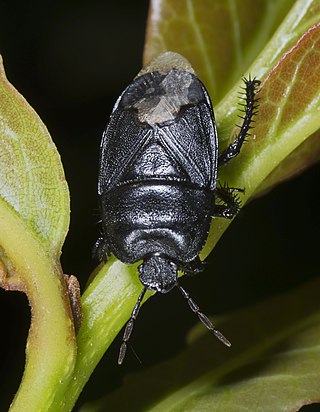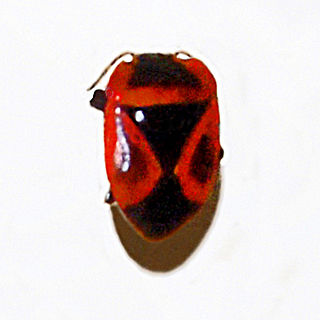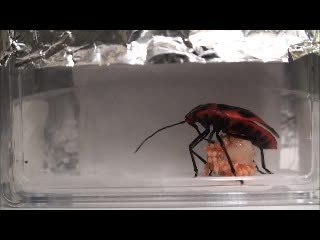Related Research Articles

The Pentatomoidea are a superfamily of insects in the suborder Heteroptera of the order Hemiptera. As hemipterans, they possess a common arrangement of sucking mouthparts. The roughly 7000 species under Pentatomoidea are divided into 21 families. Among these are the stink bugs and shield bugs, jewel bugs, giant shield bugs, and burrower bugs.

Scale insects are small insects of the order Hemiptera, suborder Sternorrhyncha. Of dramatically variable appearance and extreme sexual dimorphism, they comprise the infraorder Coccomorpha which is considered a more convenient grouping than the superfamily Coccoidea due to taxonomic uncertainties. Adult females typically have soft bodies and no limbs, and are concealed underneath domed scales, extruding quantities of wax for protection. Some species are hermaphroditic, with a combined ovotestis instead of separate ovaries and testes. Males, in the species where they occur, have legs and sometimes wings, and resemble small flies. Scale insects are herbivores, piercing plant tissues with their mouthparts and remaining in one place, feeding on sap. The excess fluid they imbibe is secreted as honeydew on which sooty mold tends to grow. The insects often have a mutualistic relationship with ants, which feed on the honeydew and protect them from predators. There are about 8,000 described species.

The western conifer seed bug, often mistakenly referred to as stink bug, sometimes abbreviated as WCSB, is a species of true bug (Hemiptera) in the family Coreidae. It is native to North America west of the Rocky Mountains but has in recent times expanded its range to eastern North America, to include Ontario, Québec, New Brunswick, Nova Scotia, Michigan, Maine, Pennsylvania, New York, Connecticut, Massachusetts, and New Hampshire, and has become an accidental introduced species in parts of Europe and Argentina.

Acanthosomatidae is a family of Hemiptera, commonly named "shield bugs" or "stink bugs". Kumar in his 1974 world revision recognized 47 genera; now this number is 55 genera, with about 200 species, and it is one of the least diverse families within Pentatomoidea. The Acanthosomatidae species are found throughout the world, being most abundant in high-latitude temperate regions and in subtropical regions at high altitudes.

Cydnidae are a family of pentatomoid bugs, known by common names including burrowing bugs or burrower bugs. As the common name would suggest, many members of the group live a subterranean lifestyle, burrowing into soil using their head and forelegs, only emerging to mate and then laying their eggs in soil. Other members of the group are not burrowers, and live above the soil layer, often in close association with plants. Several species are known as agricultural pests.

Tosenini is a tribe of cicadas in the family Cicadidae. There are at least 10 described species in Tosenini, found in the Palearctic and Indomalaya.

The Corimelaeninae are a subfamily of shield bugs within the family Thyreocoridae. It has often been treated as a family (e.g.), but the name Thyreocoridae, published in 1843, has nomenclatural priority over Corimelaenidae, published in 1872.

Urostylididae is a family of true bugs and is considered a basal or "primitive" family within the stink-bug lineage. They are found only in Asia. Older works used the spelling Urostylidae but this clashes with the name used for a protozoan family and a spelling correction (emendation) has been suggested that also avoids the confusion created by homonyms. The family name Urolabididae has also been used for some members in the past.

The Thyreocoridae are a family of shield bugs, known by common names that include negro bugs or ebony bugs. Historically, a few authors have called this family "Corimelaenidae" (e.g.), but the name Thyreocoridae, published in 1843, has nomenclatural priority over Corimelaenidae, published in 1872. Other classifications have placed them as a subfamily within the broad family Cydnidae.

Dinidoridae is a small family of hemipteran "true bugs" comprising about sixteen genera and a hundred species the Hemiptera suborder Heteroptera. As a group the family does not have any common name. Until the late 19th century they were generally regarded as a subfamily of Pentatomidae.

Parastrachiidae is a family of true bugs belonging to the order Hemiptera. It had been considered to be a subfamily under family Cydnidae, but it was raised to family status in 2002.

Parastrachia japonensis is a species of true bugs belonging to the family Parastrachiidae. It is one of the two species in the genus, both from Eastern Asia.

Cydninae is a subfamily of burrowing bugs in the family Cydnidae. There are about 11 genera and at least 40 described species in Cydninae.
Distantada is a genus of cicadas in the family Cicadidae, found in the Mascarene Islands. There is at least one described species in Distantada, D. thomasseti.
Jassopsaltria is a genus of cicadas in the family Cicadidae, found in Australia. There is at least one described species in Jassopsaltria, J. rufifacies.
Talcopsaltria is a genus of cicadas in the family Cicadidae. There is at least one described species in Talcopsaltria, T. olivei, found in Australia, in Queensland. The genus was first described in 2008 by Maxwell Sydney Moulds.

Tamasini is a tribe of cicadas in the family Cicadidae, found in Australia. There are at least two genera and about eight described species in Tamasini.
Thophini is a tribe of cicadas in the family Cicadidae, found in Australia. There are at least two genera and about nine described species in Thophini.

Cyclopelta is a genus of Dinidorid bug found in Africa and Asia. There are 14 species in the genus with 8 found in Asia and 6 in Africa. Some species are known to form large aggregation on trees and can cause damage in a few trees of economic importance.
Burmese amber is fossil resin dating to the early Late Cretaceous Cenomanian age recovered from deposits in the Hukawng Valley of northern Myanmar. It is known for being one of the most diverse Cretaceous age amber paleobiotas, containing rich arthropod fossils, along with uncommon vertebrate fossils and even rare marine inclusions. A mostly complete list of all taxa described up until 2018 can be found in Ross 2018; its supplement Ross 2019b covers most of 2019.
References
- ↑ Gengping Zhu; Guoqing Liu; Wenjun Bu & Jerzy A. Lis (2013). "Geographic distribution and niche divergence of two stinkbugs, Parastrachia japonensis and Parastrachia nagaensis". Journal of Insect Science. 13 (102): 1–16. doi:10.1673/031.013.10201. PMC 4012745 . PMID 24738857.
- ↑ Jerzy A. Lis (2010). "Pretarsal structures in the family Parastrachiidae (Hemiptera: Heteroptera: Pentatomoidea)". Zootaxa. 2693: 60–62. doi:10.11646/zootaxa.2693.1.5.
- ↑ Robert G. Foottit, Peter H. Adler Insect Biodiversity: Science and Society, John Wiley and Sons, 2009, ISBN 1-4051-5142-0
- ↑ L. Filippi; M. Hironaka; S. Nomakuchi & S. Tojo (2000). "Provisioned Parastrachia japonensis (Hemiptera: Cydnidae) nymphs gain access to food and protection from predators". Animal Behaviour. 60 (6): 757–763. doi:10.1006/anbe.2000.1526. PMID 11124873. S2CID 1369288.